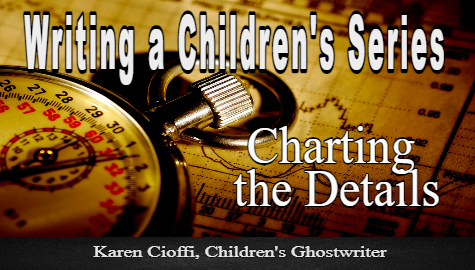Writing a series can be rewarding and also challenging.
Think about it.
With a single chapter book, middle grade, or young adult, you need to keep track of all the details.
With a series, there’s a lot more to keep track of.
Linda Wilson has a helpful article on charting the details of your series:
The Challenge is in the Details
Begin your children’s book series by creating worksheets to keep track of the details. This will help avoid the pitfalls of time spent having to flip back to previous books for small (or large) details that may have escaped you. Preparing your series worksheets isn’t much different than keeping track of the details for each of your writing projects. To accomplish this for each individual book project:
- Keep a separate notebook for each book.
- In each notebook, preferably during the first stage, create a chart of the following important information. This will take time but will be worth it. The information will be at your fingertips to tweak as you go along, and also to use for school visits, your blog, etc.
These are the categories you should have:
- Age group
- Genre
- Verb tense
- Point of View
- Mood or tone
- Setting
- Time span
- Character list, role played in your story and profiles
- Theme
- List of Scenes or contents of chapters
- Concept sentence
- Why you wrote your book
- Where your idea came from
- Research: what you researched, what file it’s kept in, sources you’ve cited
- Books by other authors that are similar to your book or that you used as models
- A list of your favorite authors, your favorite books and the authors’ bios
Ideas on how to Organize your Series
Keep a separate section or separate notebook if you’ve created a series. A series organizational chart can contain information similar to the charts for your books.
- Series title
- Genre
- List of characters and how this list changes from book to book
- How the books tie together
- How your characters grow and change as the series progresses
- Series timeline
- Settings
- Keep track of the series books you’ve read and notes you’ve taken
- Most important: write down how your series will end
- Also: keep track of special information pertaining to your story, such as in my MG mystery, the chapter(s) and page numbers of when the ghost appears.
Join the Fun
One of the most fun parts of writing a series for me has been reading popular and well-loved series by other authors.
- Take notes on the books you’ve read and on how the series is connected.
- Note who the mc is and how the mc changes and grows
- Are there new characters introduced? Which ones stay the same in each book?
What’s so intriguing is the difference in how the books are connected from series to series. In the Stepping Stones series of chapter books about ghosts by Marion Dane Bauer, each book has different mc’s and characters; the connection is that each book is about a ghost-of-a-different-color: The Blue Ghost, The Green Ghost, The Red Ghost, The Golden Ghost. And the delightful Princess in Black series by Shannon Hale and Dean Hale, in which sweet Princess Magnolia must handle a monster problem when her glitter-stone ring rings. Out bursts the Princess in Black for her next adventure, which is different in each book.
When I first realized that two of my projects could become series I was intimidated. But, after studying the nature of series writing I’ve come to realize that planning is key, as it is for the creation of any book, either right from the start or the plans emerge sometime during the revision stage. I plan to avoid as many pitfalls as possible by following the advice of authors who have shared their expertise and experiences. I hope this information will help you, too.
About the Author
Linda Wilson, a former elementary teacher and ICL graduate, has published over 100 articles for adults and children, and six short stories for children. Recently, she completed Joyce Sweeney’s online fiction courses, picture book course and mystery and suspense course. She has currently finished her first book, a mystery/ghost story for 7-11 year-olds, and is in the process of publishing it and moving on to new writing projects. Follow Linda on Facebook.
This article was originally published at: https://www.writersonthemove.com/2016/11/series-writers-chart-details-part-3.html
Let me take a look at your notes, outline, or draft. I’m a working children’s ghostwriter, rewriter, and coach. I can turn your story into a book that you’ll be proud to be author of.
Shoot me an email at: kcioffiventrice@gmail.com (please put Children’s Ghostwriter in the Subject line). Or, you can give me a call at 834—347—6700
Let’s get your story in publishable shape today!
Or, if you’d rather give it a shot and do-it-yourself, check out my book, HOW TO WRITE A CHILDREN’S FICTION BOOK.
MORE ON WRITING FOR CHILDREN
Secondary Characters – Are They Important?
Be a Successful Writer Even if You Don’t Think You Have Enough Time


